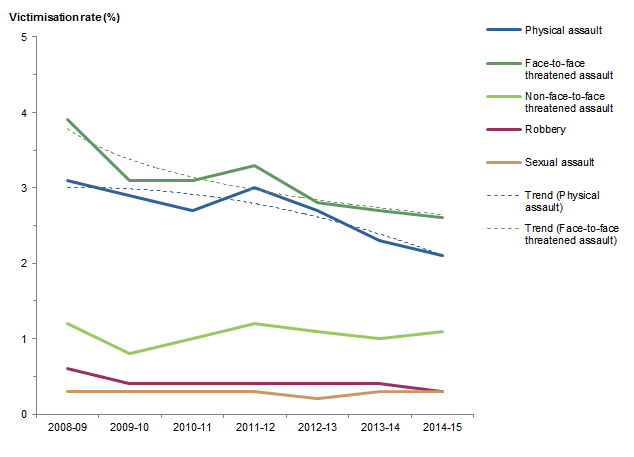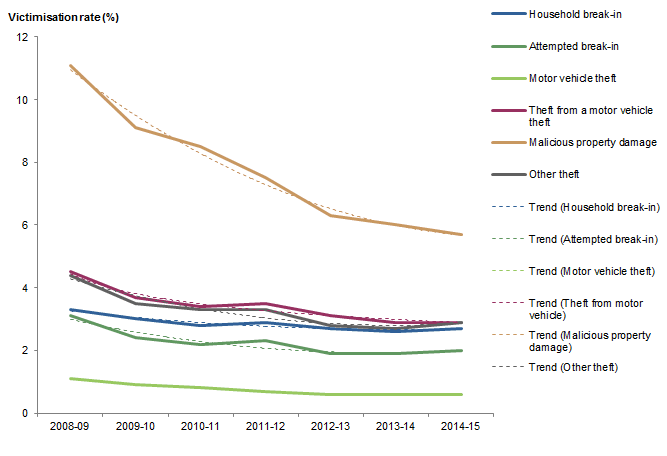CHANGE IN RATES OF CRIME OVER TIME Endnote 1
HOW HAVE PERSONAL CRIME VICTIMISATION RATES CHANGED OVER TIME? (Table 4)
The national victimisation rate in 2014-15 for persons who experienced selected personal crime types (physical assault, face-to-face threatened assault, non face-to-face threatened assault, robbery and sexual assault) was not significantly different from 2013-14.
Changes in the victimisation rate over time were examined by fitting functions to the data to find the function of best fit. This analysis showed a general decline in the victimisation rate for physical assault and for face-to-face threatened assault since 2008-09. There was no clear pattern in the victimisation rate for robbery or for sexual assault over the same time period.
Victimisation Rates for Selected Personal Crimes, Australia, 2008-09 to 2014-15(a)(b)

Footnote(s): (a) The functions used to analyse patterns of change in national victimisation rates over time have not taken into account the survey error associated with the annual victimisation rates. This is expected to have a negligible impact on the analysis, as the survey error is small. For further information on survey error refer to the Technical Note.
(b) Fitted functions are as follows: physical assault is a polynomial function with equation y = -0.0262x2 + 0.0595x + 2.9714, R2 = 0.8504; face-to-face threatened assault is a logarithmic function with equation y = -0.587ln(x) + 3.7863, R2 = 0.8256
Australian Bureau of Statistics
© Commonwealth of Australia 2016.
Source(s): VICTIMISATION RATES FOR SELECTED PERSONAL CRIMES, Australia, 2008-09 to 2014-15
HOW HAVE HOUSEHOLD CRIME VICTIMISATION RATES CHANGED OVER TIME? (Table 5)
The national victimisation rate in 2014-15 for households that experienced selected household crime types (break-in, attempted break-in, motor vehicle theft, theft from a motor vehicle, malicious property damage and other theft) was not significantly different to 2013-14.
Changes in the victimisation rate over time were examined by fitting functions to the data to find the function of best fit. This analysis showed a general decline in the victimisation rate for all of the selected household crime types since 2008-09.
Victimisation Rates for Selected Household Crimes, Australia, 2008-09 to 2014-15(a)(b)

Footnote(s): (a) The functions used to analyse patterns of change in national victimisation rates over time have not taken into account the survey error associated with the annual victimisation rates. This is expected to have a negligible impact on the analysis, as the survey error is small. For further information on survey error refer to the Technical Note.
(b) Fitted functions are as follows: household break-in is a polynomial function with equation y = 0.0226x2 - 0.2774x + 3.5143, R2 = 0.8997; attempted break-in is a polynomial function with equation y = 0.0476x2 - 0.5452x + 3.4857, R2 = 0.895; motor vehicle theft is a polynomial function with equation y = 0.0179x2 - 0.225x + 1.3, R2 = 0.9934; theft from a motor vehicle is a power function with equation y = 4.4439x-0.222 , R2 = 0.9504; malicious property damage is a polynomial function with equation y = 0.1143x2 - 1.7929x + 12.629, R2 = 0.9858; other theft is a polynomial function with equation y = 0.0595x2 - 0.7119x + 4.9286, R2 = 0.9201
Australian Bureau of Statistics
© Commonwealth of Australia 2016.
Source(s): VICTIMISATION RATES FOR SELECTED HOUSEHOLD CRIMES, Australia, 2008-09 to 2014-15
ENDNOTE
Endnote 1 All comparisons discussed have been tested for statistical significance with a 95% level of confidence that there is a real difference in the two populations being tested. Only data with a relative standard error (RSE) of less than 25% are referred to in the text of this publication and these estimates are considered sufficiently reliable for general use. To determine whether there is a statistical difference between any other two estimates, significance testing should be undertaken. For further information, refer to the Technical Note.
 Print Page
Print Page
 Print All
Print All
 Quality Declaration
Quality Declaration